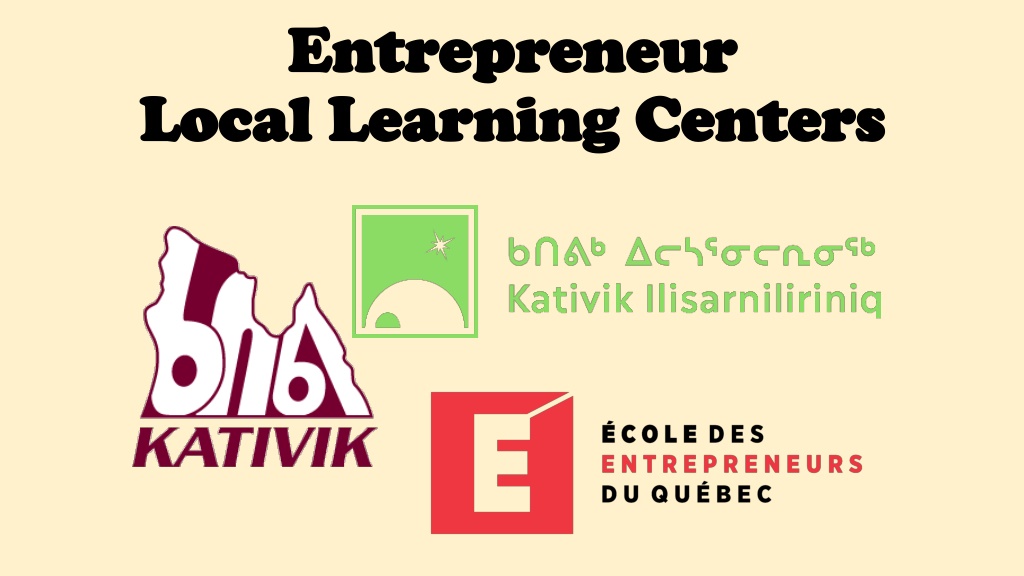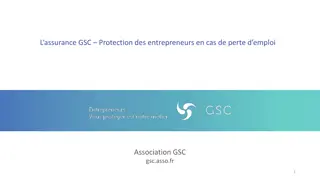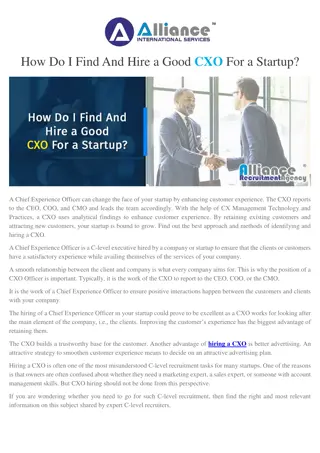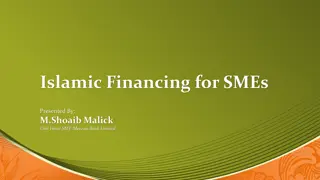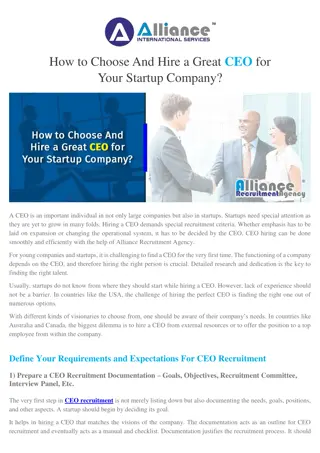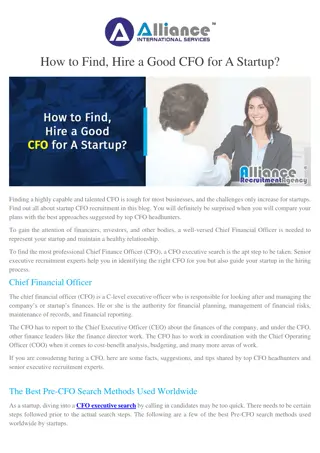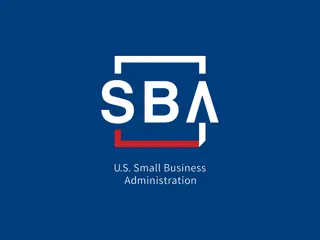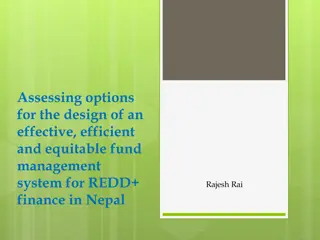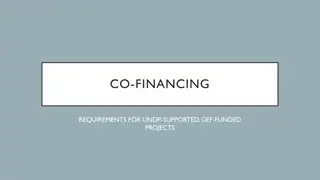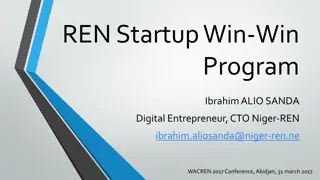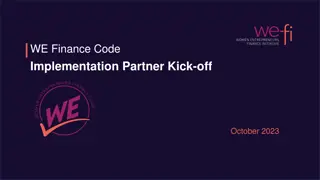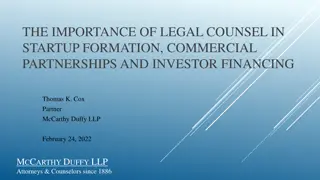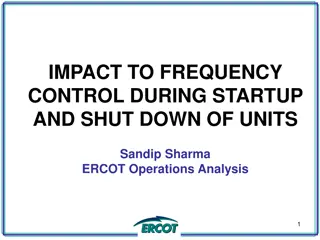Understanding Startup Costs and Financing Options for Entrepreneurs
Exploring the challenges of estimating startup costs for new businesses, this content discusses the importance of financial planning and potential sources of financing. It covers steps to evaluate costs, ways to save on expenses, and considerations for self-funding ventures. Entrepreneurs are guided on assessing their capital, financing options, and the significance of personal investment in their business endeavors.
Download Presentation

Please find below an Image/Link to download the presentation.
The content on the website is provided AS IS for your information and personal use only. It may not be sold, licensed, or shared on other websites without obtaining consent from the author. Download presentation by click this link. If you encounter any issues during the download, it is possible that the publisher has removed the file from their server.
E N D
Presentation Transcript
Entrepreneur Entrepreneur Local Learning Centers Local Learning Centers
SEMINAR 31: SOURCES OF EQUITY FINANCING Do I have enough money to go into business? Before you rush to open a shop, how much money do you need to start a business? This infamous question is one that new entrepreneurs sometimes have a hard time answering! One of the biggest challenges for small businesses is getting adequate financing. Some entrepreneurs will need almost nothing to start their business, like a graphic designer who would only need his computer and a web page, but others will have high start-up costs. Here are the main steps to evaluate the start-up cost and potential sources of financing.
Getting Started One of the biggest challenges for small businesses is getting adequate financing. Some entrepreneurs will need almost nothing to start their business, like a graphic designer who would only need his computer and a web page, but others will have high start-up costs. Here are the main steps to evaluate the start-up cost and potential sources of financing.
How to Estimate the Cost of Starting A Business Drafting a business plan is the best way to assess your business start-up costs. - Equipment and leasehold improvement costs are often thought of first and can be very expensive. Still, many other expenses must be included in start-up costs, such as advertising costs, graphic design costs, registration/incorporation costs, office supplies, start-up inventory, licenses, etc. All the expenses incurred only once, at the start of the business, can be considered start-up costs. - Do not forget to include sufficient working capital to cover a 3 to 6-month operation cycle in the total cost of your project. It s prudent to cover three (3) to six (6) months worth of expenses minimum upfront; this financial cushion will support you in your business s early stages when your profit margins might be slim. - What are some ways to save on start-up costs? Using software like QuickBooks can save on the costs of hiring a professional bookkeeper. Working from home or using a coworking space is a cost-effective alternative to leasing office space. And leveraging social media can mitigate your marketing costs. Continued
How to Estimate the Cost of Starting A Business Cont d. Once the start-up cost has been determined, ask yourself: how do I finance it? What are my options? Should I Invest my own money? What are my options/sources of equity to leverage for financing? For self funding, you need to ask yourself: What capital do I have? Do I believe in my project? Am I ready to invest my personal resources into my business?
Lets Apply these Lessons to an Example: Preparing your first budget will help you define the fixed costs and the variable costs, then determine the number of periods/months for which the start-up income is insufficient. Kuujjuaq Colorful Scarves has estimated their start-up cost at $10 500: Salary Sales fees Administration fees Subtotal start-up costs (rollover 2 months 2 months 3 -4 months $ 3 833 $ 168 $ 512 funds + excess liquidity) Inventory purchases Assets Total project cost $ 4 491 $ 3188 $ 2 800 $ 10 500 1 month 1month Continued
Kuujjuaq Colourful Scarves then decided to finance the project with $2000 in self- funding and borrow $ 8000 from the bank to buy equipment for a 2 year term at a 12 % interest rate.
Cash and Other Assets or Bootstrapping A first step would be to complete your personal financial statement to assess your net worth. To do this, you can simply go to the personal balance sheet tab of the excel file. It will allow you to identify your assets versus your liabilities and, therefore, if you have adequate funds to invest. Bootstrapping is founding and running a company using only personal finances or operating revenue. This form of financing allows the entrepreneur to maintain more control, produce more efficiently, and carry no debt or obligation to a third party. However, It also can increase financial strain. You should also always separate personal versus company assets/equity. That being said, this method should always be your first option. Unfortunately, most young entrepreneurs don t have much in assets or money, and if your idea is complex enough, you'll need to bring in outside sources of capital.
What To Do When You Don't Have Enough Money To Start A Business? Here are the main categories of equity financing sources: 1- Investors 2- Business Loans and Grants 3- Crowdfunding Continued
Investors 1. Investors Love Money - Family Donations: Family donations or love money come from just that! Your friends and family. It is a great way to raise funds without giving up equity or control in your company. You could consider partnering with someone or another company (Joint venture). This form of financing is an excellent way of sharing risks, costs, and liabilities with a partner. When a partner invests in your business, they buy shares in your business in exchange for money or sometimes assets. If each contributes 50 percent of the start- up money, each is entitled to 50 percent of the profits. See also: SEMINAR 20: What are joint ventures and partnerships for more details.
Investors, Contd. What are the differences between an Angel Investor and a Venture Capitalist? An angel investor works alone, while venture capitalists are part of a company. They are usually used for more significant needs in financing. The main advantage is that form financing is much less risky than debt financing. Unlike a loan, invested capital does not have to be paid back in the event of business failure. Angel investors, or business angels, are individuals who invest their time and money in a start-up in exchange for an equity share. Angel investors will have a say in how the business is run and receive a portion of the profits when and if the company is sold. Given that they are investing their own money, there is always a risk. An angel will invest in a business owner willing to give away a part of their company. Compared to traditional debt financing, a lending institution like a bank has no control over the operations of your business and takes no share of the profits.
Investors Contd. Venture Capitalist Venture capital firms are a group of professional investors. Their capital will come from individuals, corporations, pension funds, and foundations. Desjardins Capital is a fund manager offering financial support to innovative start-ups in Quebec. Receiving venture capital means giving up some level of your control in your business. In return, you also have access to Experienced leadership and advice, and increased publicity and exposure are likely. On the other hand, funding is difficult to obtain. The overall cost of financing is expensive. A formal reporting structure and board of directors are required, and funds are released immediately; they are usually released upon an objectives/performance schedule.
What To Do When You Don't Have Enough Money To Start A Business, Cont d. That covers the Investors side of equity financing sources. Now, we ll be talking about: 2. Business Loans Definitions: Grants, also known as funding, are amounts you don t have to repay and are usually based on your financial need, while loans are amounts you borrow and pay back, usually with interest fees. Inuit Business Development Fund can provide funding for a business start-up for up to $20,000. Makigiarutiit, I and II Fund can provide loans, contributions, and investments for up to $150,000. Makigiarutiit III Fund can provide funding to women and youth for business development and entrepreneurship for up to $500,000 and Grants The Regional and Local Development Department offers programs and services to support the region s business development: Continued
Business Loans and Grants, Cont d. The bank or Caisse Desjardins loans are the most common form of debt financing. Other debt financing means taking loans from family and friends and borrowing through a credit card. - Debt Financing Over the Short-Term Businesses use short-term debt financing to fund their working capital operations. It can include paying wages, buying ifor day-to-day nventory, or costs incurred for supplies and maintenance. The scheduled loan repayment is usually within a year, and the interest rate is typically higher. - Debt Financing Over the Long-Term Long-term debt financing purchases assets, such as buildings, equipment, and machinery. The assets that will be purchased are usually also used to secure the loan as collateral. The scheduled repayment for the loans is usually up to 10 years, with monthly payments and fixed interest rates lower than the short-term loans. A common type of short-term financing is a line of credit or credit card. This financing is not recommended for typical start-up costs such as equipment and machinery. Continued
Debt Financing, Contd. Here are some of the Pros and Cons of Debt Financing. Advantages of Debt Financing Disadvantages of Debt Financing Preserve company ownership The need for regular income Tax-deductible interest payments Adverse impact on credit ratings Late payments can lead to a potential bankruptcy
What To Do When You Don't Have Enough Money To Start A Business, Cont d. Now for our final source of Equity Financing: 3. Crowdfunding Crowdfunding is a way for an entrepreneur to raise money by collecting small, individual contributions from a large pool of donors through online platforms such as Kickstarter, GoFundMe, and Indiegogo. They are known as La ruche, Ulule, Ma Belle Terre, and other social networks in Quebec. There are many forms of crowdfunding; the most common are Donation/rewards-based crowdfunding and equity crowdfunding. Continued
Crowdfunding, Contd. Donation Crowdfunding: The entrepreneur sets a fundraising target and asks for donations. In this form of crowdfunding, donors receive something in return for their contributions. The rewards vary depending on the size of the donation. Equity Crowdfunding allows start-ups to give away a portion of their business in exchange for funding. These donations are a type of investment where participants receive shares in the company based on how much money they contribute. Based on how much money participants give to a campaign, they may receive a T-shirt, a thank you note, and other types of gifts, the product, or service, often at a discounted rate. Donation/rewards crowdfunding is also a great form of market testing and marketing research, seeking the opinion of your target audience. It offers minimal upfront fees. There is minimal financial risk with almost no start-up debt. If the target is not met, the funds are returned to the investors.
What is Equity Leverage? Equity Leverage refers to using borrowed money to increase the return on investment. If the return on the total value invested (total equity) in the project (your cash + borrowed funds) is higher than the interest you pay on the borrowed funds, you can make a significant profit. The table on the next slide will help to illustrate this concept
In case number # 1: Case- 1 $10 000 $2 000 $12 000 Case- 2 $2 000 $10 000 $12 000 I invested 2000 $ of my own money and borrowed 10 000 $. The return rate on my equity is 15% and the debt interest rate is 5 %. I have made 1300$ with 2000$ from my own pocket, ROI of 65 %. Debt Capital Invested Total equity Return on investment (%) Interest cost (%) Return on investment ($) (Total equity X Return on investment %) Interest cost ($) (Debt x Interest cost (%) Profits ($) ( Return on investment - Interest cost) 15% 5% 15% 5% $1 800 $1 800 In case number # 2: $500 $100 I invested 10 000 $ of my own money and borrowed 2 000 $. These were done at the same rates. I have made 1700$ with 10 000 $ from my own pocket, making an ROI of 17 %. $1 300 $1 700 Return on investment (ROI) (%) (Profits / Capital Invested) 65% 17%
